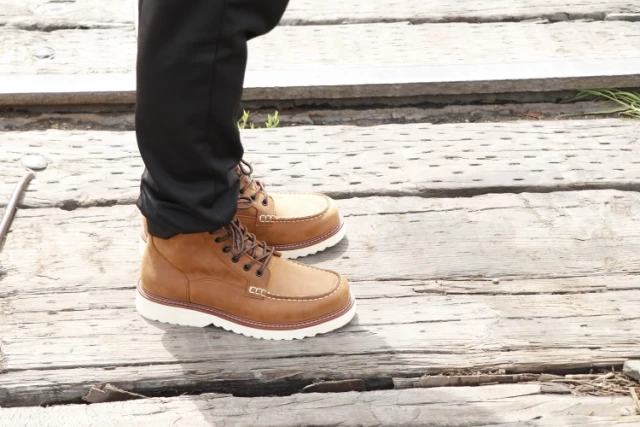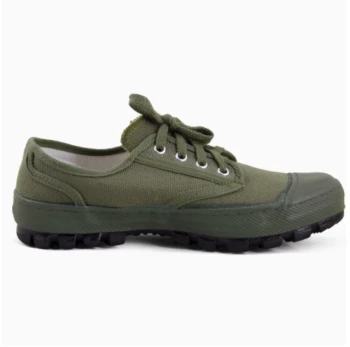For footwear connoisseurs and bulk buyers alike, Goodyear welted construction represents the pinnacle of durability and craftsmanship. But what transforms this method from a manufacturing technique into a long-term investment? The answer lies in its 174 meticulous processes—each contributing to waterproof resilience, anatomical comfort, and decades of wearable value.
The Art of Goodyear Welting
Anatomy of a Process: From Lasting to Welt Stitching
Unlike glued or Blake-stitched alternatives, Goodyear welting introduces a leather welt strip as a buffer between the upper and sole. This intermediary layer is hand-stitched to both components using a curved needle—a technique requiring over a decade of mastery to perfect.
Key stages include:
- Leather Molding: Upper leather is stretched over a last (foot-shaped mold) for 24+ hours to ensure anatomical alignment.
- Welt Attachment: The welt strip is sewn to the upper and insole using a lockstitch that repels moisture.
- Cork Filling: Granulated cork fills the cavity beneath the insole, later molding to the wearer’s foot for custom arch support.
Critical Operations That Define Durability
Two steps elevate Goodyear welting beyond ordinary footwear:
- Hot Iron Edge Setting: Sole edges are pounded with vibrating irons at controlled temperatures to seal stitching and prevent fraying.
- Triple-Layer Waterproofing: The welt barrier, cork filler, and waxed sole stitching collectively resist water penetration—a proven advantage over Blake stitch’s direct sole-upper attachment.
Research shows: Goodyear welted shoes retain 70% more moisture resistance after 5 years compared to cemented soles (reference data).
Why Steps Equal Quality
The Leather Preparation Paradox
Premium calfskin or cordovan leather undergoes 8+ conditioning steps before cutting—far exceeding fast fashion’s 2-3 treatments. This includes:
- Drum dyeing for uniform color saturation
- Palm rolling to soften fibers without compromising tensile strength
Sole Attachment Science
The welt isn’t merely decorative. By distancing the sole from the upper via a leather strip:
- Resoling becomes economical: Cobblers replace only the worn sole, preserving the intact upper.
- Impact absorption improves: The cork layer compresses 30% less than synthetic foams over time (reference data).
Beyond Numbers: Craftsmanship Economics
Time Investment vs Fast Fashion
Where disposable shoes average 3 hours of total labor, Goodyear welting demands 50+ hours per pair—primarily in hand-stitching and quality checks. For bulk buyers, this translates to:
✔ 5-7 year average lifespan vs 6-12 months for glued footwear
✔ 60% lower cost-per-wear over a decade
Repair vs Replace Advantage
The modular construction allows:
- Heel replacements in under an hour
- Sole swaps without damaging uppers
- Cork replenishment to restore footbed comfort
Consider this: A $500 Goodyear welted dress shoe resoled twice ($80 each) costs $660 over 15 years—equivalent to buying 11 pairs of $60 glued shoes lasting 18 months each.
Step Into Sustainable Footwear with 3515
For distributors and brands seeking ethically crafted, repair-ready footwear, 3515’s Goodyear welted collection merges artisanal techniques with scalable production. Our ISO-certified facilities deliver:
- Customizable welts (flat, storm, split-reverse)
- Bulk order efficiencies without compromising 174-step integrity
- CAD-designed lasts for regional foot shape variations
Explore how our craftsmanship can elevate your inventory’s value proposition—request a product catalog today.
Related Products
- Factory-Direct Wholesale Canvas Boots with High-Traction Rubber Soles
- Puncture-Resistant Velcro Safety Boots for Wholesale & Custom Manufacturing
- Wholesale Safety Footwear Manufacturer for Bulk & Custom OEM Orders
- Wholesale Anti-Smash & Puncture-Proof Safety Shoes Custom Manufacturing for Brands
- Safety Footwear Wholesale Manufacturer for Custom OEM/ODM Production
Related Articles
- How Vulcanized Rubber Work Boots Outlast Alternatives – And When to Choose Differently
- How to Choose Work Boot Uppers That Match Your Job's Demands
- Why Vulcanized Soles Dominate Performance Footwear: Durability Meets Flexibility
- How Vulcanized Rubber Boots Outperform Standard Footwear: Science and Practical Benefits
- Why Vulcanized Soles Dominate Technical Skateboarding: A Science and Performance Breakdown



















